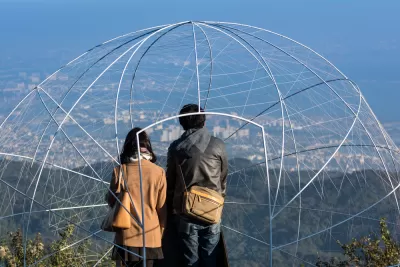Decades ago, Walter Benjamin theorized that pretty much everything could be reproduced—and, therefore, nothing was unique. This dismal conclusion, however true it may be, ignores the uniqueness of landscape.

"Even in the 1930s, it wasn’t hard to imagine that the same mechanical processes that were producing cars and phones and chemicals could be trained to produce art as well. Or, rather, reproduce it. Benjamin does not discount the importance of the artist in the creation of original work. But he implies that human mastery of chemistry and materials science, paired with the precision of the assembly line, could essentially produce copies indistinguishable from their originals and do so in limitless numbers."
"What struck me then as I strolled those expectant streets (possibly in ways that the residents never will) was that, for all the sameness of the homes, each one retained an essential uniqueness. Those developments, like most such developments, offered a few designs, each with lame, disembodied names like 'The Nantucket' or whatever. They weren’t so much designs as they were collections of amenities and necessities united under roofs. And yet, each occupied its own special, if not necessarily distinctive, plot of desert."
"That’s why I take solace in special places and un-special places alike. And it’s why I put a degree of faith in architecture, even when so many other human endeavors have slid into banality and self-reference. Of course, not every architect can, or should, be another Utzon or Meier. The world will always need far more workaday structures than it does masterpieces. The more we must strain to see our auras amid the banality of postmodern life, the more we may need to tighten our grip on the incredible places humanity has created."
FULL STORY: The Work of Architecture in the Age of Mechanical Reproduction

Study: Maui’s Plan to Convert Vacation Rentals to Long-Term Housing Could Cause Nearly $1 Billion Economic Loss
The plan would reduce visitor accommodation by 25,% resulting in 1,900 jobs lost.

North Texas Transit Leaders Tout Benefits of TOD for Growing Region
At a summit focused on transit-oriented development, policymakers discussed how North Texas’ expanded light rail system can serve as a tool for economic growth.

Why Should We Subsidize Public Transportation?
Many public transit agencies face financial stress due to rising costs, declining fare revenue, and declining subsidies. Transit advocates must provide a strong business case for increasing public transit funding.

How to Make US Trains Faster
Changes to boarding platforms and a switch to electric trains could improve U.S. passenger rail service without the added cost of high-speed rail.

Columbia’s Revitalized ‘Loop’ Is a Hub for Local Entrepreneurs
A focus on small businesses is helping a commercial corridor in Columbia, Missouri thrive.

Invasive Insect Threatens Minnesota’s Ash Forests
The Emerald Ash Borer is a rapidly spreading invasive pest threatening Minnesota’s ash trees, and homeowners are encouraged to plant diverse replacement species, avoid moving ash firewood, and monitor for signs of infestation.
Urban Design for Planners 1: Software Tools
This six-course series explores essential urban design concepts using open source software and equips planners with the tools they need to participate fully in the urban design process.
Planning for Universal Design
Learn the tools for implementing Universal Design in planning regulations.
City of Santa Clarita
Ascent Environmental
Institute for Housing and Urban Development Studies (IHS)
City of Grandview
Harvard GSD Executive Education
Toledo-Lucas County Plan Commissions
Salt Lake City
NYU Wagner Graduate School of Public Service





























